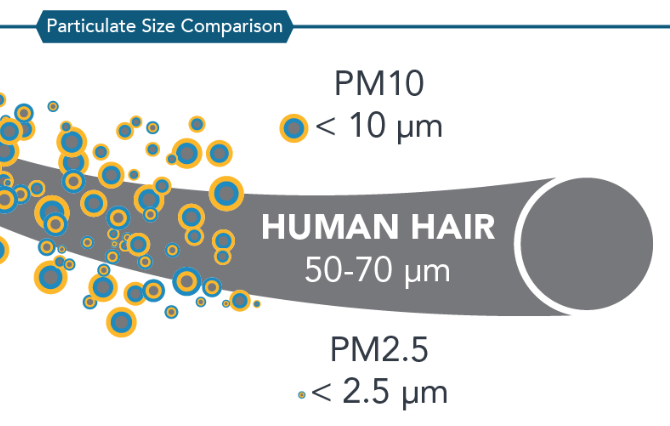Besides gaseous air contaminants in your home, there are other suspended pollutant particles. The particles can either be fluid or solid-state with divergent diameters and compositions. The floating particles are best referred to as particulate matter (PM). So what is PM10 in air pollution?
We categorize the particles by their sizes. PMx defines the particle size of airborne particles, with x representing the diameter of particles. For example, a PM10 particle has a diameter of 10 microns, while a particle with PM2.5 has a diameter of 2.5 microns.
Examples of PM10 pollutants are:
- Mould
- Pollen
- Dust
Particulate matter can be emitted from primary sources (for example, your kitchen) and through chemical reactions of gases such as sulphur dioxide and nitrogen dioxide.
Besides, natural sources also emit the airborne particulate matter in your home, for example, trees, pets, and artificial sources such as fuel combustion.
Why Should You Be Concerned with PM10?

You should be concerned about airborne particles because of their effects on human health. When you inhale PM10 pollutants, they get deposited throughout the respiratory system (from the nasal cavity to the lungs).
Due to the diameter of PM10, the particles are likely to be deposited in the upper region of your lungs. The deposition can result in tissue damage and lung inflammation.
Exposure to PM10 can also lead to adverse health effects. Short-term exposure to PM10 worsens respiratory diseases such as asthma and obstructive pulmonary disease, leading to hospitalization.
On the other hand, long-term exposure to PM10 can lead to chronic respiratory diseases and premature death.
Also, exposure to PM10 poses a greater risk to children and adults with chronic heart or lung disease. Additionally, children with immature immune systems are more vulnerable to PM 10 effects than healthy adults.
Our Recommendation
There is particulate matter suspended in the air in your home. Some of the particles come from the outdoors and some from indoor sources. Some indoor particulate matter comes from activities in your home such as smoking tobacco, cooking, burning wood, and use of aerosols.
On the other hand, some come from biological sources such as pollen, mould spores, and dust mites.
What should you do?
To get ambient air quality, we recommend getting an air purifier. An air purifier is the best gadget to improve your life by efficiently cleaning pollutants in your home. A quality purifier needs to be powerful enough to clean the air in your room.
Further, it would help if you bought an air purifier with a sensor to monitor air quality in your home in real-time. Purifiers with sensors automatically detect the concentration of pollutants and adjust the fan speed. The fan adjusts to high and low speeds depending on the air quality.
We have reviewed the best air purifiers Canada and you should find a good option for your home or office. These air purifiers have top-notch filtration systems including but not limited to HEPA filters.
Conclusion
PM10 particles are common air pollutants. The particles are tiny enough to get into your respiratory system. When the levels are high, the pollutants can cause respiratory irritation and make you cough, have a running nose, or even make your eyes itchy.
In extreme cases, they can lead to asthma attacks and aggravate symptoms for people with heart and lung conditions. To avoid the adverse effects of PM10, buy an air purifier to restore the ambience in your room.

